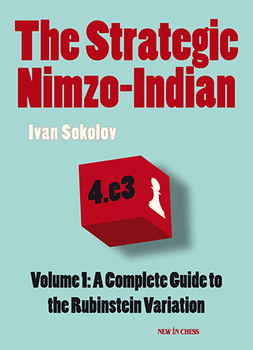| Nivå | C-D |
| Utgivelsesdato | Mars 2012 |
| Forfatter | |
| Pris | 340 NOK |
The Strategic Nimzo-Indian Volume 1
A Complete Guide to the Rubinstein VariationEn ny formidabel åpningsbok fra New In Chess. Ivan Sokolov er stor ekspert på 4.e3 mot Nimzoindisk som denne store boka handler om. Han slo bl.a. Kasparov med trekket i 1999. Neste bind vil handle om 4.a3.
Forord
My research on the Nimzo-Indian Defence started in the mid-1980s. A few factors contributed to this. In Yugoslavia at the time, there was a widely studied analytical work by Mikhail Botvinnik, a trilogy of his own games. Nimzo-Indians were regularly fea tured in these games – like for example in his World Championship matches against Vasily Smyslov, but also in many other games by Botvinnik. Svetozar Gligoric was a big protagonist of the Nimzo with 4.e3 and an active player at the time, and his games were al ways closely fol lowed in Yugosla via. Sometime in these years I also received a number of books: on the finals of the So viet Championships of the 1950s (fea tur ing games by Efim Geller, Alexander Kotov et al), David Bronstein’s Zürich 1953, and Gligoric’s game collection I play against pieces, with many Nimzo games with the moves 4.e3 and 4.a3 analysed in them.
At that time I was starting to build a 1.d4 repertoire. From a practical point of view, employing the Nimzo-Indian with the white pieces (contrary to the Queen’s In - dian) made my opening preparation considerably easier since now I did not have to study so many different opening variations, like the Vienna Vari a tion, the Ragozin, the Semi-Tarrasch, etc. Some of my first successes, like win ning the Yugoslav championship in 1988 and the Crown Group in Biel that same year, I can ascribe to a consider able extent to my wins in the 4.e3 Nimzo Indian. Later on, perhaps the most beautiful moment of my career was when I beat Garry Kasparov in Wijk aan Zee 1999 – also with a Nimzo-Indian with 4.e3.
Starting from 1985, I have broadened my knowledge of the 4.e3 lines over the years, and ultimately I played all of them with white. It al ways seemed to me that for White 4.e3, the Rubinstein Variation, or 4.a3, the Sämisch Variation, were the most logical, the most classi cal (although in theoretical manuals the ‘Classical Variation’, also known as the ‘Capablanca Variation’, is considered to be the one with 4.Qc2) ways for White to meet the Nimzo-Indian. With 4.e3 (the Rubinstein Variation) White plays a natural developing move, ignoring for the time being Black’s bishop on b4 and keeping his options open. With 4.a3 (the Sämisch Variation) White forces Black to execute his ‘threat’ of taking on c3 and double White’s b- and c-pawns. In re turn for this doubled pawn, White is to build a strong pawn centre. This al ways seemed more important to me than the ‘meaning less’ weakness of White’s c4 pawn. Of course this preference is purely personal! Rather often, White also starts with 4.e3 and at a later stage, i.e. usually a move or two later, he plays a2-a3, transposing to Sämisch positions. The original idea of this book was to cover both the 4.e3 and the 4.a3 lines. Dur ing the process of analysing and writing, it transpired that I had underestimated the quantity of the material, and that the 4.e3 variation alone was going to considerably exceed the originally ear marked total number of pages! It was therefore decided that the Sämisch Variation will be dealt with in a separate book, which will be published in the beginning of 2013.
White has many different options to fight in the Rubinstein Variation. He can develop his knight to e2 early (with the bishop still on f1), or later (after playing Bd3), or he can de velop the knight to f3 (which is the most popular) – he can play with an iso lated pawn, or with con nected hang ing pawns in the centre, or es tab lish a central pawn symmetry, etc, etc. Black, on the other hand, can choose be tween an early bishop fianchetto with 4…b6, a line loved by great players like Smyslov and Fischer, or 4…c5, attacking the white centre right away, or the flexible 4…0-0, which is the most played in recent top tournaments. The choices that are made on both sides are – or should be – motivated by the players’ preferences for certain pawn structures that arise further on in the respective lines. Understanding the pawn structures and the strategic rules that are connected with them is more crucial than a pure re hashing of variations here. A majority of pawn structures in the 4.e3 lines and their related strategic choices I have tried to explain in my book Winning Chess Middlegames (New In Chess 2009). I strongly advise the reader to study the stratetic ins and outs of the respective pawn structures, and find out where his own preferences lie before taking the final decision as to which line to pick up for his personal opening repertoire.
In this book I have tried (success fully, I hope) to explain the ideas in the Nimzo-Indian with 4.e3 and to give an objective view of the state of affairs in this opening, irrespective of my personal preference for the white side. I hope that you, reader, will enjoy this book and that you will be able to success - fully employ the knowledge you gain from it in your tournament play.
Ivan Sokolov, January, 2012
| Innbundet? | Nei |
| Type | Bok |
| Språk | Engelsk |
| Antall sider | 411 |

